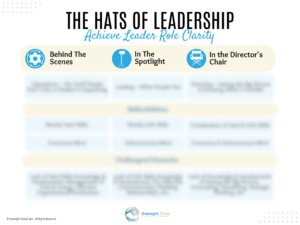
Leadership is a critical element in any organization or community, and leaders are expected to possess various skills and abilities to help them accomplish their tasks effectively. However, many leaders often feel lost, wondering what is expected of them and what their priorities should be, especially when they are newly appointed to a leadership position. This lack of clarity could become a significant hindrance to effective leadership. Thus, it is crucial for leaders to understand and know their role and expectations to overcome this feeling and perform their duties excellently.
One way to understand the different aspects of leadership is through a concept I created, use and teach called the “Hats of Leadership.” The Hats of Leadership comprises of three aspects or what I call ‘buckets.’ They are: ‘Behind the Scenes’, ‘In the Spotlight’ and ‘In the Director’s Chair.’
The first bucket, ‘Behind the Scenes’, is all about operations and refers to the tasks that keep a leader’s department and ultimately the organization running smoothly. This aspect of a leader’s role is what people don’t tend to see or even realize is occurring as it’s happening behind the scenes. This aspect includes things like budgeting, planning, and logistics. The skills required for this aspect include things like attention to detail, problem-solving, and analytical thinking. These tasks generally rely on the conscious mind, as they require a high level of focused attention.
One of the biggest challenges faced by leaders in this aspect is the constant need to balance competing priorities. Effective leaders in this area must be able to efficiently manage resources, handle multiple tasks simultaneously, and make quick decisions based on available information.
The second bucket, ‘In the Spotlight,’ is about guiding, inspiring, motivating and empowering others. This is the aspect of a leader’s role that people see and is all about the act of leading. This includes tasks such as public speaking, team building, and mentorship. The skills required for this aspect include charisma, emotional intelligence, and communication. These tasks generally rely on the subconscious mind, as they tap into deeper emotions and motivations.

One of the biggest challenges faced by leaders in this aspect is that they are always under the watchful eyes of their team and stakeholders. Effective leaders in this area must be able to cultivate trust, inspire loyalty, and motivate others even in challenging circumstances.
The third bucket, ‘In the Director’s Chair,’ entails seeing the big picture and knowing what’s possible. It’s about leaders setting the long-term vision for their departments which are in alignment with and progress their organization’s vision and drives strategic planning. This includes tasks such as trend analysis, forecasting, and planning for the future. The skills required in this aspect include strategic thinking, innovation, and adaptability. These tasks require a balance of both the conscious and the subconscious mind.
One of the biggest challenges faced by leaders in this aspect is the need to constantly anticipate and adapt to changes in the market, industry, or broader global context. Effective leaders in this area must be able to think creatively, anticipate future challenges, and develop innovative solutions to address them.
By understanding these three aspects or buckets and the challenges involved in each, leaders can better define their roles and expectations and prioritize their tasks accordingly. In doing so, leaders can effectively manage their time and resources, build trust and inspire loyalty in their team, and drive innovation and growth for their organization.
Leaders can also use this framework to identify areas where they need to grow or develop their skills. For example, a leader who struggles with public speaking may need to focus on building their charisma and communication skills to become more effective in the ‘In the Spotlight’ aspect of their role.
In summary, knowing your role and expectations as a leader is critical to becoming an effective and successful leader. By understanding the ‘Hats of Leadership’ framework, leaders can define their roles and expectations, prioritize their tasks accordingly, and develop the skills and abilities needed to thrive in each bucket. This, in turn, will help them build a strong, motivated team and drive innovation and growth for their organization.
If you enjoyed this blog post and found it helpful, be sure to share it using the share links below!
Mastering the Hats of Leadership: A Guide to Navigating Leadership Expectations
July 29, 2023


